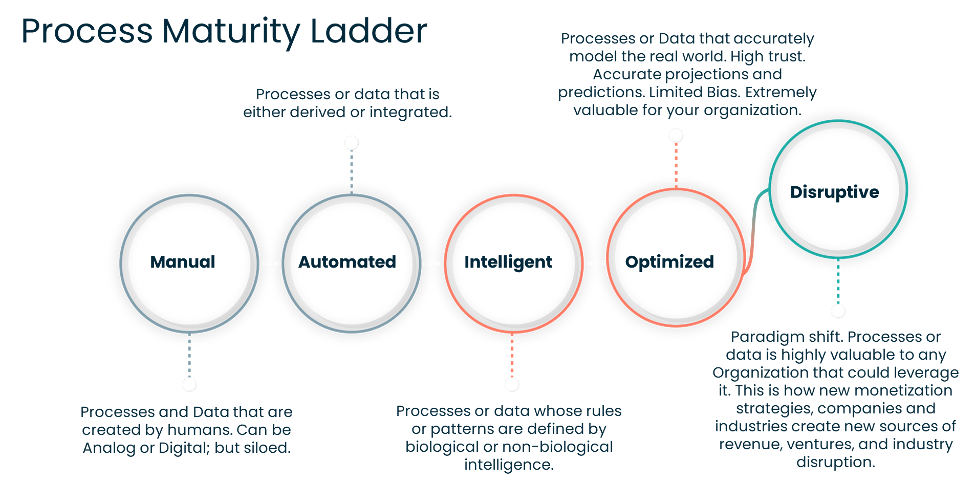What you’ll learn:
- The Artificial Intelligence inflection point is here
- Boomi has a pragmatic roadmap for navigating AI disruption
- Data quality, trust, and security are your most valuable assets
You’re a leader in your organization and worried your business could fail within a year.
Like most leaders, you probably have reliable visibility into the next few quarters, and standard indicators are strong. Financials look sufficient. NPS scores are good. Employee morale is solid. The macroeconomic environment remains uncertain, but you helped prepare the business for further headwinds.
Yet, you’re kept awake at night because, seemingly out of nowhere, disruptive technology has taken society by storm like none other before — artificial intelligence that feels like it’s human. We’re approaching the dawn of artificial general intelligence.
The Artificial Intelligence Inflection Point is Here
In your career, you’ve seen fads filled with bold promises of tech that will revolutionize or disrupt the world! Early adopters acted. Fast followers listened. Perhaps you took your chances and stayed the course. Then, after the hype dissipated, your business did just fine and maybe even thrived.
But this time is different, and you can feel it. We’ve reached an inflection point where society is about to be changed. Here’s what you and your business are facing: a freight train. You have two choices. 1) Get run over. 2) Climb aboard.
Boomi has a framework that can help you navigate the coming change by defining the current state of your business operations, optimizing processes, and implementing AI functionality in a way that’s most relevant for your organization and your customers.
First, how did we get here?
Each major epoch had an inflection point – a critical mass – when societal change unfolded that disrupted the status quo. Usually, it’s tied to advances in technology. Consider how pre-agrarian (hunting and gathering) times lasted tens of thousands of years. Then, the Agriculture Revolution unfolded over thousands of years. The Industrial Revolution took hundreds of years to manifest. The Digital Revolution took hold in just tens of years.
Now, the AI revolution is here, and its impact on society is measured in months, not years. Time is compressing from one revolutionary epoch to the next1. And just like the previous monumental shifts, society will change. It’s noteworthy that the time between each shift is compressing.
This is why leaders of any business have a choice: adapt or risk it all. AI is genuinely transformative. At the same time, companies that aren’t adept at embracing it could very well cease to exist. Yes, it seems dramatic when stated that way, but that’s also the reality.
You need to prepare for that new reality – today.
Boomi’s Pragmatic Roadmap for Navigating AI Disruption
This article launches a series we’re calling “Meeting You Where You’re At.” To start, we’ll introduce you to the Process Maturity Ladder (PML) framework.
Readying your business for the coming changes requires you to closely examine the processes that run your business and the data you produce or consume. We propose that you consider a ladder of five states of processes within the organization: Manual, Automated, Intelligent, Optimized, + Disruptive: MAIO +D.

Manual: Processes are entirely in the realm of human touch and human error. They’re also prolific in nearly every organization. Many manual processes are unknown to many, poorly documented, and not maintained well – if at all. Manual processes contain valuable data. But few know how that data is collected and reported. They also increase risk, impede revenue, and increase the cost. Likely, more than half of your business is still running on these processes. Examples are handwritten forms and spreadsheets. The goal for your organization should be to systematically root out manual processes.
Automated: These processes take humans out of the loop. Many companies have automated the flow between producers and consumers of data. Perhaps connections and APIs are familiar to you. If so, you are on your way with an automated process. But there’s always room for improvement. We’ll elaborate so that you can elevate your process to the next level.
Intelligent: Automated processes that can achieve value-based outcomes. Before thinking about intelligence as AI, take a breath. Intelligent processes need not necessarily incorporate machine learning, neural networks, or transformers (don’t worry, I will cover the differences in a future post) to be intelligent. The point is that the data from the process adds value because of context and rules. Once a process is intelligent, it can be refined.
Optimized: Refined processes that are accurate, precise, and fit for purpose. You can count on them. Predict outcomes, prescribe actions, and have more trust in the decisions you make about your business. Changes will be foreseeable, obstacles avoidable, and risks manageable. Optimized processes formulate the critical mass that becomes a gateway to potential disruption.
Disruptive: You will change the course of your team, department, enterprise, or industry. Disruptive processes can take on a life of their own, including, but not limited to, becoming a business of its own within an enterprise or spinning out into another company. For those lucky enough to be part of or, better, make a disruptive process real, this can be an exciting and rewarding endeavor.
Data Quality, Trust, and Security are Your Most Valuable Assets
Disruptive processes require unique or differentiated data. This is called a data moat. It can include how you organize your data, track the usage of products or services, and analyze business performance, among many things.
Your data moat is your competitive advantage. It’s where your company turns data into information — and information into actionable intelligence. It protects your organization’s most valuable assets: the people, processes, and technology. It’s also a place that begins to form when consistent pipelines drain into it. This starts with automation and builds from there.
You need a pragmatic roadmap to prepare you for the AI revolution, to meet your organization’s processes where they’re at, and to build them to be disruptive. Embracing it requires work — a lot of it.
This series is for stakeholders throughout the enterprise. This series is for you if you run a division, group, or operation within your organization. Whether you’re technical, and especially if you’re not, read this series. Question it. Question your processes. Ask how you can improve your processes to harness the AI storm upon us.
My goal is to provide concrete actions you can take to prepare your enterprise for the future. We all have to learn how to “train our dragon.” AI can either destroy our businesses, or we can climb on its back and soar to new heights.
The choice will be ours.
Prepare your data for the AI revolution with the TDWI Checklist Report: Five Steps for Accelerating Data Readiness. This eBook helps you evaluate your data needs, outline data governance best practices for your organization, and how to prepare your data infrastructure for AI / ML applications.
[1] Kurzweil, Ray, “The Singularity is Near,” Viking Press, 2005

 English
English 日本語
日本語